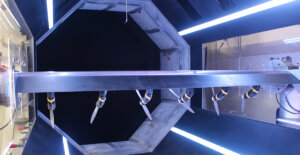
Madeleine Yee and Vamsi Chinta. PHOTO/MADELEINE YEE.
USC Viterbi School of Engineering researchers recently won 2nd place for a poster presentation at the 74th annual American Physical Society Division of Fluid Dynamics conference in Phoenix, AZ. The team was led by Associate Professor Mitul Luhar, with graduate student leads Vamsi Chinta and Chan-Ye Ohh and co-author USC Viterbi Professor Geoffrey Spedding. The research also included high school students, Madeleine Yee and Philbert Loekman, who were also co-authors as part of the 2021 SHINE program.
The poster, titled “Regime Classification for Stratified Wakes from Planar Velocity Field Snapshots Using Convolutional Neural Networks,” focuses on the wake flow an object makes as it moves through water or air. Think of a boat moving through a lake, and the ripples it leaves behind. This is an example of a “wake flow.”
“This wake can contain useful information about the moving body. As a result, it may be possible to figure out what object created the wake and how fast it was moving by looking at the type of flow left behind,” Chinta said.
“We used machine learning techniques typically used for image recognition (i.e., similar to the algorithms used by google to figure out if a picture has a cat, dog, person or car in it) to see if we could classify wake flows from limited snapshots of the flow field behind the moving object,” Chinta said.
Below is an animation demonstrating the evolution of a wake behind a sphere. (VIDEO/Chan-Ye Ohh .)
Introducing Youth to Research
The SHINE program, which stands for Summer High School Intensive in Next-Generation Engineering, provides high school students with a real-life research experience as part of a professor’s research team. The award-winning poster was built on research carried out by Yee and Loekman.
“During SHINE21, I worked with another SHINE student to classify hydrodynamics wakes into predetermined categories. Using machine learning to train and test the computer, we developed a code to classify the different wakes with around 85-90% accuracy,” said Yee, whose father received his Ph.D. from USC Viterbi.
Yee feels that her experience in the SHINE program allowed her to better understand the research process. “Through the program, I learned that aerospace engineering, specifically fluid dynamics, is a field I want to pursue in college and eventually earn a Ph.D. in. I plan to continue my efforts in research and turn my passion for fluid dynamics into a successful career,” Yee said.
Loekman feels that their work has importance for its potential in its biological impact and national security. “We would be able to track marine animals such as the female green sea turtle and track the migration of it through the seasons, giving us a better understanding of the ecological nature of the ocean. On the other hand, we could possibly identify threats that may be harbored in nearby waters. The possible benefits are endless for the entire world,” Loekman said.
Loekman said his only regret was not asking more questions during the program. “SHINE has prepared and exposed me to the research world in such a significant way that will have lasting effects for the rest of my life. With such close connections with my mentors, I was able to communicate in a way that had made me more devoted and determined to achieve my goals,” Loekman said.
To read more about the students’ experience through SHINE, see their individual blogs on the conference here:
Published on February 16th, 2022
Last updated on February 16th, 2022











